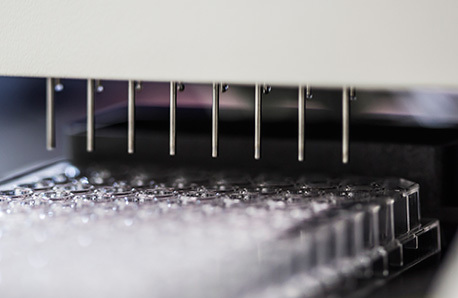Tests
EliSpot
EliSpot, also known as T-Spot, is a technology used to assess the functional immune response of T cells to various antigens by means of enzyme-linked immuno-spot assays.

Diagnostic options with EliSpot
Our laboratory employs EliSpot as one of our key technologies to measure cellular immunity and aid in the diagnosis of various hard-to-detect infections.
A broad spectrum of testable diseases:
The EliSpot enables the examination of a variety of infections and pathogens, including well-known agents such as Ehrlichia & Anaplasma, Bartonella, Babesia, as well as viral infections caused by Epstein-Barr virus (EBV), herpes simplex virus, cytomegalovirus, and others.
A deep insight into the immune system:
By measuring the cellular immune response, the EliSpot not only offers the possibility to monitor the efficacy of therapies but also provides insights into T cell-mediated immune responses in a variety of infections. Its high sensitivity and specificity make it a valuable tool in the diagnosis and monitoring of infectious diseases.
EliSpot – A versatile tool in infectious disease diagnostics:
Our laboratory utilizes EliSpot technology to diagnose and monitor a wide range of infections. Due to its broad applicability and its ability to accurately capture the cellular immune response, the EliSpot significantly contributes to the precise diagnosis and treatment of infectious diseases.
The Borrelia EliSpot can eliminate some problems
- The test reflects the current Borrelia burgdorferi activity of chronic and recent Borrelia burgdorferi infections.
- The EliSpot is highly sensitive and can detect even one single Borrelia burgdorferi-reactive T-cell. With detection levels that can be as low as one cell in 100.000, the EliSpot is one of the most sensitive cellular assays available.
- The EliSpot is between 20 and 200 times more sensitive than a conventional ELISA.
- The EliSpot displays a similar sensitivity as a RT-PCR (Real Time PCR) analysis, but detects the secreted protein instead of the DNA
- The EliSpot can be helpful when monitoring therapies. The EliSpot should usually become negative about 4 to 8 weeks after the completion of an effective therapy.
What can be tested with the EliSpot?
Lyme disease
Infections with Borrelia burgdorferi not only elicit a humoral immune response in the form of Borrelia-specific antibody production but also concurrently activate the cellular immune response in the form of specific T lymphocytes (EliSpot test). Once Borrelia are no longer active in the body, the T-cellular immune response should promptly diminish, resulting in a negative EliSpot test.
It is generally not possible to assess the treatment success of an effective therapy for Lyme disease using Borrelia antibodies because the antibody "titer" in the blood can persist for years. Recently acquired infections with Borrelia burgdorferi (e.g., symptoms of erythema migrans or summer flu after tick bite) often manifest weeks later in the form of antibody production. Additionally, the detection of Borrelia-specific antibodies may yield negative results despite an actual infection due to inadequate standardization and low sensitivity of ELISA and immunoblot tests. In such cases, the Borrelia EliSpot test can often bridge the diagnostic gap.
The Borrelia EliSpot can address some of these issues.
- The test reflects the current activity of the pathogen in both chronic and fresh/acute infections (Note: erythema migrans or summer flu after tick bite) with Borrelia burgdorferi.
- The EliSpot is highly sensitive and can detect even a single T cell responding to Borrelia burgdorferi. With detection limits reaching up to one cell in 100,000, the EliSpot is one of the most sensitive cellular testing methods available.
- The EliSpot is between 20 and 200 times more sensitive than a regular ELISA antibody test.
- Therefore, the EliSpot is similarly sensitive to an RT-PCR test (Real Time PCR), but it detects the pathogen protein instead of the DNA
- The EliSpot can be helpful in monitoring therapies. It should typically return negative 4 to 8 weeks after the end of an effective therapy.
Borrelia EliSpot
T-Cell-Spot / IGRA: Interferon-Gamma-Release Assay
Borrelia EliSpot antigens:
- Borrelia burgdorferi Fully Antigen: Borrelia burgdorferi B31-reference strain (Borrelia burgdorferi sensu stricto)
- Borrelia burgorferi Peptide-Mix: OspA from Borrelia b. sensu stricto, Borrelia afzelii, Borrelia garinii + OspC native + DbpA recombinant
- Borrelia burgdorferi LFA-1 (Lymphocyte Function Antigen 1): Own body protein + Borrelia burgdorferi sensu stricto (shared epitope). Often associated with autoimmune diseases: collagenosis, Rheumatoid Arthritis, vasculitis (ANA, CCP-antibodies, ANCA)
Explanation: Native = cultured antigens/ Recombinant: genetic technology produced
Reflecting the current T-cellular activity of Lyme disease:
- Indication for a currently active Borrelia burgdorferi infection in cases of furthermore positive EliSpot after the end of therapies
- T-Cell-Spot/IGRA has been approved by the FDA in May 2011 for M. tuberculosis: "… A positive result suggests that an infection is likely, a negative result suggests that an infection is unlikely…” “…Results can be available within 24 hours…”
EliSpot: New T-Cell Test a “Game Changer” for Lyme disease:
- The sensitivity of EliSpot is estimated at 84%, and the specificity is at 94%.
- EliSpot assays provide robust, highly reproducible data.
- EliSpot can be retested for the acquisition of additional information in follow-up assays.
- the two assays systems (EliSpot + CD57-cell count) compliment each other in the quest to understand T cell-mediated immunity in vivo.
